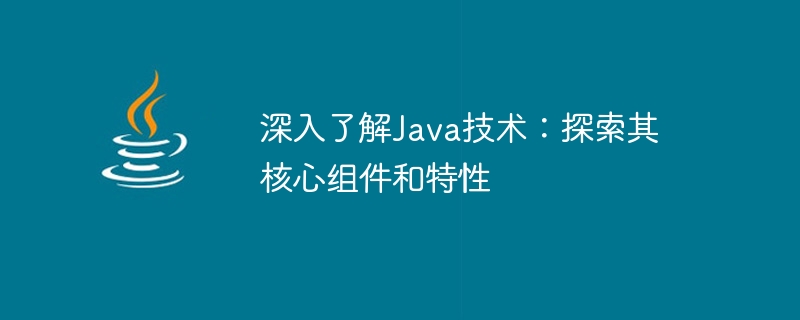Home >Java >javaTutorial >An in-depth exploration of the core components and features of Java technology
An in-depth exploration of the core components and features of Java technology
- WBOYWBOYWBOYWBOYWBOYWBOYWBOYWBOYWBOYWBOYWBOYWBOYWBOriginal
- 2024-01-13 09:56:051190browse

In-depth understanding of Java technology: to explore its core components and features, specific code examples are required
Introduction:
Java is an object-oriented programming language. After years of development and optimization, it has become one of the most commonly used languages in the field of software development. Java has the advantages of portability, cross-platform, and security, and is widely used to develop various applications, including desktop applications, embedded systems, mobile applications, etc. This article will deeply explore the core components and features of Java and provide specific code examples to help readers better understand and apply Java technology.
1. One of the core components of Java: classes and objects
Classes and objects in Java are the basis for establishing the entire program structure. A class is an abstract data type that defines the properties and methods of an object. An object is an instantiation of a class, and specific data and behaviors are displayed by the object. The following is a sample code of a simple Java class and object:
// 定义一个Person类
public class Person {
// 定义对象的属性
private String name;
private int age;
// 定义对象的方法
public void setName(String name) {
this.name = name;
}
public void setAge(int age) {
this.age = age;
}
public String getName() {
return name;
}
public int getAge() {
return age;
}
public void displayInfo() {
System.out.println("Name: " + name + ", Age: " + age);
}
}
// 创建Person对象并使用对象的方法
public class Main {
public static void main(String[] args) {
// 创建一个Person对象
Person person = new Person();
// 设置对象的属性
person.setName("John");
person.setAge(25);
// 调用对象的方法
System.out.println("Name: " + person.getName());
System.out.println("Age: " + person.getAge());
// 调用对象的方法显示信息
person.displayInfo();
}
}In the above code, the Person class defines two attributes, name and age, and provides corresponding setter and getter methods. At the same time, a displayInfo method is also defined for displaying object information. In the main method of the Main class, we create a Person object and use the object's methods to set properties, obtain properties and display information.
2. Java Core Component 2: Exception Handling
Java's exception handling mechanism can help developers deal with errors and exceptions that may occur when the program is running. Using exception handling, you can make your program more robust and fault-tolerant. The following is a sample code for simple Java exception handling:
public class Main {
public static void main(String[] args) {
try {
// 可能会抛出异常的代码
int result = divide(10, 0);
System.out.println("Result: " + result);
} catch (ArithmeticException e) {
// 捕获并处理异常
System.out.println("Error: " + e.getMessage());
}
}
public static int divide(int num1, int num2) {
// 抛出异常
if (num2 == 0) {
throw new ArithmeticException("Divide by zero");
}
return num1 / num2;
}
}In the above code, the divide method may throw an ArithmeticException. In the main method, we caught and handled this exception through the try-catch statement block. If no exception is thrown, the result will be printed normally; if an exception occurs, an Error message will be printed.
3. Java core component three: multi-threading
Java's multi-threading mechanism allows the program to perform multiple tasks simultaneously in the same process, improving the execution efficiency of the program. The following is a simple Java multi-threading sample code:
public class Main {
public static void main(String[] args) {
// 创建并启动Thread子类的实例
MyThread thread1 = new MyThread("Thread 1");
MyThread thread2 = new MyThread("Thread 2");
thread1.start();
thread2.start();
}
}
// 自定义一个Thread子类
public class MyThread extends Thread {
private String name;
public MyThread(String name) {
this.name = name;
}
@Override
public void run() {
for (int i = 0; i < 5; i++) {
System.out.println(name + ": " + i);
try {
// 休眠一段时间
Thread.sleep(100);
} catch (InterruptedException e) {
e.printStackTrace();
}
}
}
}In the above code, we customized a MyThread class, inherited from the Thread class, and overridden the run method. In the run method, we loop to output the thread name and counter, and sleep for a period of time through the Thread.sleep method after each loop. In the main method of the Main class, we create two instances of MyThread and start the two threads respectively.
The above sample code is just the tip of the iceberg of Java technology. The classes and objects, exception handling, and multi-threading are all very basic and important components and features in Java programming. By having an in-depth understanding of Java's core components and features, developers can better apply and integrate various functions and write efficient and stable Java programs.
The above is the detailed content of An in-depth exploration of the core components and features of Java technology. For more information, please follow other related articles on the PHP Chinese website!
Related articles
See more- A brief analysis of laravel's core component illuminate
- List the important core components of React Native
- Decryption of PHP8 underlying development principles and exploration of new features: how to improve code quality
- Sharing successful cases of using Java technology to optimize database search performance
- Explore an introduction to the core components and features of the Java technology platform

